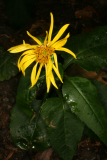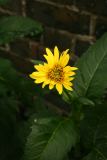Additional notes (click to expand)
Medicinal
Cup plant was employed medicinally by several native North American Indian tribes who used it to treat a variety of complaints. A decoction of the root has been used to treat the stoppage of periods, and also to treat morning sickness and to prevent the premature birth of a child.
Moerman, Daniel E. (2009) Native American Ethnobotany. Timber Press. p.531
Other use
Silphium perfoliatum L. Asteraceae Indian Cup. Distribution: North America. Austin (2004) records that another species, S. compositum, was used by Native Americans to produce a chewing gum from the dried sap of the roots, and Native American medicinal uses for 'Indian Cup' are probably referable to S. compositum and not S. perfoliatum. Silphium perfoliatum contains enzymes that inhibit trypsin and chymotrypsin which gives it resistance to fungal, bacterial and insect attacks. Male gall wasps (Antisotrophus rufus) alter the chemistry of the plant to enable them to locate females, making it a 'signpost' plant. The gall wasp lays its eggs in the stem of Silphium laciniatum, to provide food for the larva on emergence, and the galls containing a male or a female wasp will cause the plant to give off a different chemical odour. Emerging male wasps can search for female wasps, which emerge later, by locating this chemical fragrance which acts as a sex pheromone proxy (Tooker et al Proc Natl Acad Sci U S A. 2002 Nov 26;99(24):15486-91). No medicinal or other uses for S. perfoliatum found.
Oakeley, Dr. Henry F. (2013). Wellcome Library notes.
link
Geographical distribution
- Northern America, Eastern Canada
- Northern America, Northeastern U.S.A.
- Northern America, Southeastern U.S.A.
Silphium perfoliatum L.
Family: ASTERACEAEGenus: Silphium
Species: perfoliatum L.
Common names: Indian Cup
Distribution summary: E.N.America
Habit: Perennial
Hardiness: H7 - Very hardy
Habitat: floodplains, moist but sandy soils
Garden status: Currently grown
Garden location: North America (A)
Flowering months: July, August, September
Reason for growing: Medicinal


